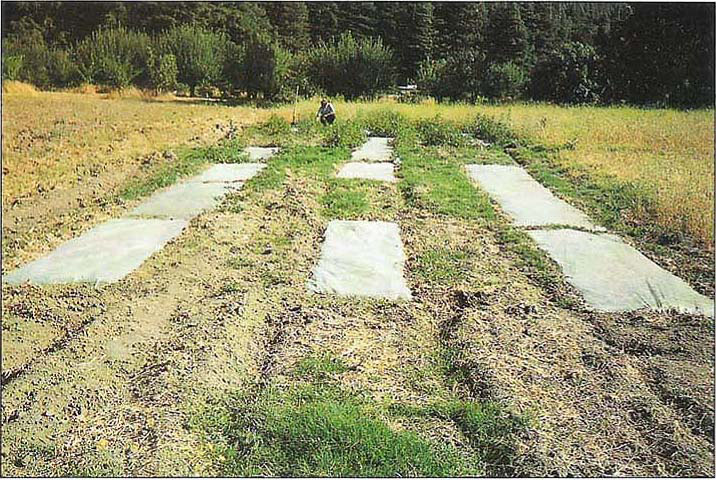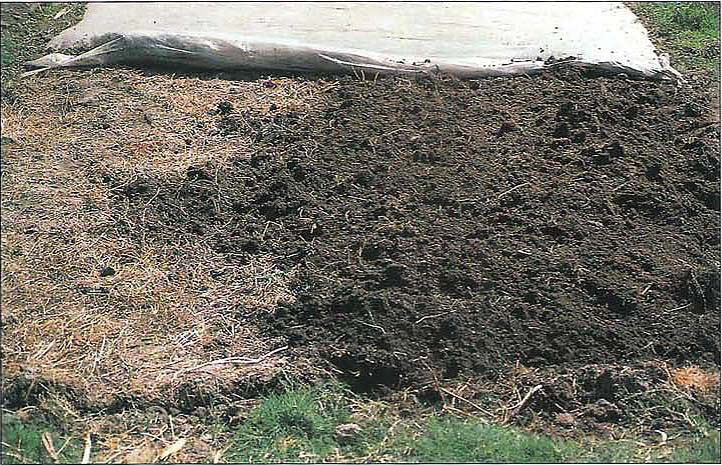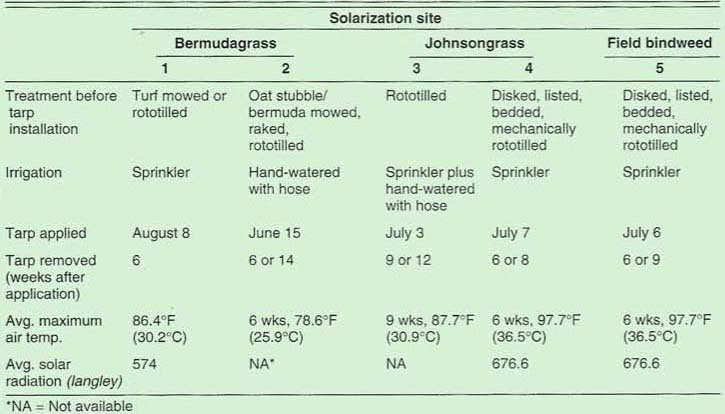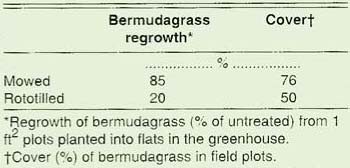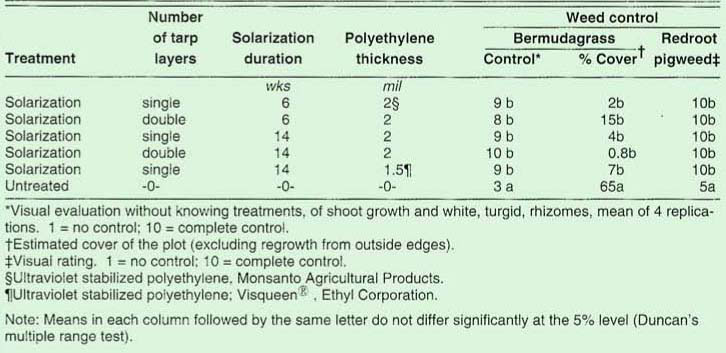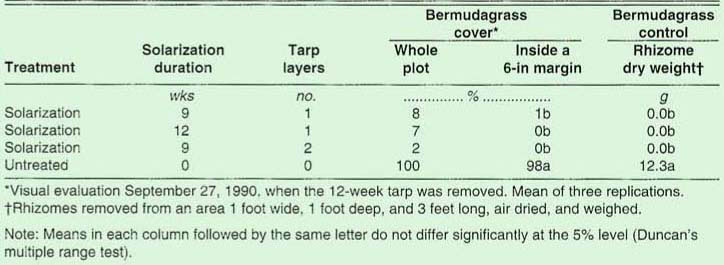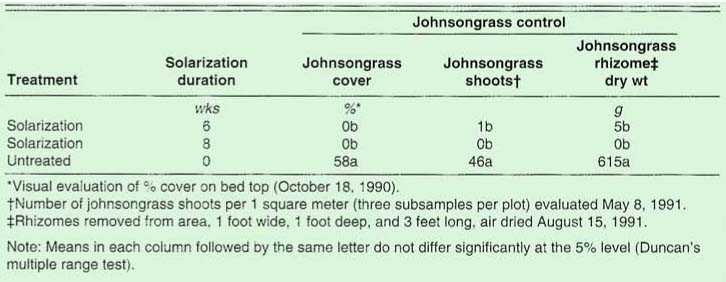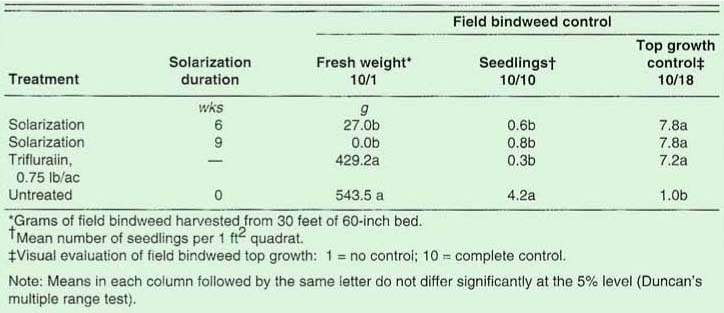All Issues
Perennial weeds respond to control by soil solarization
Publication Information
California Agriculture 47(1):19-22.
Published January 01, 1993
PDF | Citation | Permissions
Abstract
Soil solarization in summers in Central Valley and near-coastal sites controlled bermudagrass and johnsongrass covered by polyethylene tarps. Field bindweed was also controlled during solarization, but regrowth occurred. To maximize control and reduce the “edge” effect – the regrowth of weeds at the edges of fields when they are not covered by tarps – the soil must be completely covered with intact polyethylene.
Full text
Site location for bermudagrass and redroot pigweed control in Humboldt County, 1989. The picture was taken 10 weeks after solarization began. The bare strips are where tarps were removed after 6 weeks; tarps still in place indicate the 14-week solarization.
In soil solarization (soil tarping), solar energy is used to reduce soil pests. Clear polyethylene tarps may be used singly to cover pre-formed beds or they can be glued together to cover broad areas. Weed control is most effective when prepared beds are irrigated before being covered with polyethylene; however, when beds have drip lines, irrigation can take place after polyethylene is installed. Moisture under the tarp helps conduct heat and stimulates weed seeds to germinate; the heat then kills the seeds.
Winter annual species, such as annual bluegrass, common sowthistle, and shepherdspurse, are readily controlled by solarization; winter annual grasses are especially sensitive. Many summer annual species, including barnyardgrass and pigweed, are also controlled; the exception, sweet clover, is only partially controlled.
Perennial weeds are more difficult to control than annual weeds because their underground vegetative structures — rhizomes, tubers, or bulbs — allow them to survive most nonchemical controls, including cutting, cultivation, and mowing. Use of solarization, therefore, could be a desirable alternative to chemical control.
Above left, bermudagrass rhizome evaluation after solarization in Humboldt County. Soil was spaded to 1 foot, rhizomes were collected, dried and weighed.
Below left, johnsongress control after 6 weeks of solarization in Davis, California. Bare strips are where beds were solarized and the tarps removed.
TABLE 1. Preparation for weed control with polyethylene application (and removal) at five California sites
Bermudagrass, a perennial grass, forms rhizomes (underground stems) capable of covering a large area and forming numerous new plants when cut into pieces. In nontillage culture — as in orchards or landscapes — bermudagrass rhizomes may extend 6 inches deep or more. In cultivated areas, rhizomes are usually found to the depth of cultivation. These rhizomes, as well as surface stems (stolons), must be killed to eliminate this species.
Johnsongrass, another perennial grass, also forms rhizomes. Like bermudagrass rhizomes, johnsongrass rhizomes usually grow to plow depth in cultivated, light-textured soils. In nontilled areas, rhizomes often grow 4 to 6 inches deep.
Field bindweed, a broadleaf perennial weed, has a storied rootstock system that can extend as deep as 8 to 12 feet in the soil; rootstocks, however, are predominantly found in the top 18 inches of the soil profile.
The following soil solarization studies evaluated the control of the perennial weeds bermudagrass, johnsongrass, and field bindweed. Information on the preparation for all sites is summarized in table 1.
Bermudagrass studies
Control of bermudagrass was evaluated at three sites: at the University of California at Davis (site 1) and at two sites 22 miles east from the coast in Humboldt County's Eel River Valley (sites 2 and 3). The UC Davis experiments took place in 1980, while Humboldt County experiments took place in 1989 and 1990.
TABLE 2. Effects of bermudagrass sod control with solarization 4 months after tarp removal at UC Davis
The Davis location had established turfgrass sod before start of the study in 1980. Some beds at the site were mowed to 1/2 inch and others were rototilled with a garden rotovator to 4 inches deep before the tarps were laid to test whether there would be a difference in control results between mowing and rototilling. The site was sprinkler-irrigated before tilling and irrigation ceased during the solarization period. A slight decline in the slope (7%) to the north reduced the sun angle. Polyethylene tarps (2 mil) were sealed at the edges August 8,1980, by removing soil to make a trench, inserting the tarps into the trench, and covering the edges. The tarps, pulled tightiy to keep them as close to the soil as possible, were then left undisturbed for 6 weeks.
The plots, 5 feet by 5 feet, were replicated four times in a randomized complete block design. After the tarps were removed, soil samples containing bermudagrass rhizomes and other plant parts were sampled from a 1-square-foot area to 6 inches deep in each plot and placed on flats in the greenhouse; bermudagrass regrowth was then evaluated. Regrowth of bermudagrass in the field was visually evaluated as a percentage cover of the plot and compared with untreated turfgrass adjacent to the outside edge of each plot.
Site 2 in Humboldt County was heavily infested with bermudagrass and had been cropped with oats before the study began. The plots were mowed, raked free of forage, and rototilled 4 inches deep June 15, 1989. Before tarping, the soil surface was watered by hand (with approximately 1 inch of water). There was no moisture below 2 to 4 inches of the soil at the time of treatment and no subsequent application of water. Polyethylene tarps (2 or 1.5 mil) were hand placed on the plots June 15, 1989. Plots were 5 feet by 10 feet and replicated four times using a randomized complete block design. The tarps were sealed on the edges as described in the first study. Use of a standard single layer of polyethylene (1.5 mil thick) covered by a second layer was evaluated. The tarps remained on the soil for 6 or 14 weeks before removal. On September 29,1989, bermudagrass control was evaluated both by estimates of percent cover and by visual evaluation of live rhizomes excavated from the upper 1 foot of the plots (white, turgid rhizomes = alive; brown rhizomes = dead) (table 1). Control of redroot pigweed was also evaluated visually.
In 1990, another study (site 3) was established adjacent to the 1989 Humboldt County site. The field was disked and sprinkler-irrigated (with approximately 4 inches of water) before tarps were laid July 3, 1990. The plots were watered by hand to field capacity just before the tarps were sealed. As in the neighboring experiment, single or double layers of 1.5-mil polyethylene were laid. The tarps remained on the soil for 9 or 12 weeks. Plots were 5 feet by 8 feet and replicated three times. Bermudagrass control was visually evaluated in the entire plot. Live rhizomes from an area in each plot 1 foot wide, 3 feet long, and 1 foot deep were removed, air dried, and weighed.
TABLE 3. Bermudagrass and redroot pigweed control with soil solarization for 6 and 14 weeks and with one and two layers of polyethylene in Humboldt County, 1989
TABLE 5. Established johnsongrass control with soil solarization for 6 or 8 weeks in Davis, California, 1990
Johnsongrass study
Controlling johnsongrass with solarization was evaluated in a heavily infested field on the UC Davis farm (site 4). After the soil was disked and listed, beds were formed and sprinkler-irrigated with 4 inches of water. Following irrigation, the beds were mechanically rototilled and shaped into finished 5-foot-wide beds before tarps were laid. Plot size was 5 feet by 35 feet and replicated four times in a randomized complete block design. On June 20,1990, the tarps were applied to moist soil with a tractor-mounted mulching machine; they remained on the beds for 6 weeks in one treatment, and 8 in another, before they were removed. Johnsongrass shoots were counted in three subsample square meter quadrants on May 8, 1991 and the mean used for analysis. Control of johnsongrass rhizomes was determined by visual evaluation of regrowth in the plots and by measuring the dry weight of rhizomes collected from an area 1 foot wide, 3 feet long and 1 foot deep in each plot.
Field bindweed evaluation
A site at UC Davis (site 5) was heavily infested with established field bindweed. Beds were prepared like those in the johnsongrass site. The 1.5-mil polyethylene was applied to pre-formed 5-foot beds July 7, 1990 with a mechanical layer. The tarps remained on the beds for 6 weeks in one treatment and 9 weeks in another. Trifluralin at 0.75 pound active ingredient per acre (a.i./ac) was applied as a comparison treatment to the bed surface and sprinklerincorporated with 1 inch of water. Field bindweed growth from established plants was harvested from each plot October 1, 1990 and weighed. Field bindweed seedlings were counted 34 days after the tarps were removed and coverage of established shoots was visually evaluated 42 days after their removal.
Solarization's effects
Solarization reduced regrowth and coverage by rototilled or closely mowed, trash-free bermudagrass sod (table 2) at site 1 (UC Davis). Greater control of bermudagrass was achieved when the sod was rototilled than when it was mowed. Bermudagrass was effectively controlled with a single sheet of 1.5- or 2-mil polyethylene tarp when applied in summer at both sites in Humboldt County; a double layer was found to be no more effective than a single layer (table 3 and table 4). Part of the decrease in control at the Davis site compared with the cultivated Humboldt County sites was due to reduced radiation on the north-facing slope. Where holes developed in the polyethylene, bermudagrass survived and grew. However, rhizomes were killed where the polyethylene remained intact or was patched with clear plastic tape. Bermudagrass regrew in treated plots from the edges (particularly apparent on the north edge of the plot) where the soil covered the polyethylene (table 4). Rhizome regrowth occurred from rototilled or mowed plots but to a lesser extent in rototilled soil greenhouse tests (table 2).
Johnsongrass was effectively controlled with 2-mil polyethylene tarps for 6 and 8 weeks at Davis (table 5). Mature rhizomes and seedlings were controlled to 8 inches deep, the maximum depth rhizomes were found. Like bermudagrass, johnsongrass regrowth occurred if a large clump of rhizomes was not completely covered with polyethylene. Thus, there is a distinct “edge” effect when tarping to control both perennial grasses.
Controlling field bindweed with soil solarization was not as effective as perennial grass control. The number of field bindweed seedlings was reduced with solarization, but the seedlings were not eradicated (table 6). Regrowth from established field bindweed was suppressed for 6 weeks after solarization. Top growth was visually evaluated 17 days after tarp removal and was not different between tarping treatments but was significantly reduced from untreated plots. Trifluralin at 0.75 1b a.i./ac, applied to the soil surface, did not suppress field bindweed fresh weight 12 weeks after application. After top growth was removed, seedling numbers and new top growth were suppressed.



